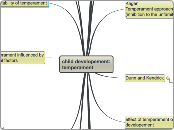child developement: temperament
Thomas & Chess (9 Dimensions)first researcher to devolp systematictheory of temperament
NYLS (New York Longtitudanal study)
Tested children at ages 3, 8 and 13
Important categorization: a.) easy’ child b.) the ‘slow to warm up’ child andc.) the ‘difficult’ child
Concept of "the difficult child"
children rated high on Intensity and Reaction and on NegativeMood and low on Adaptability, on Rhythmicity and on Approach
increased risk of later behaviour disorders.(confirmed by Earls and Jung) and others
mood, approach-withdrawal, intensity, threshold, rhythmicity, distractibility, attention span, persistence, and adaptability
5 robust factors
resemble the "big 5"
2 inconsistent ones
threshold and biological rhythmicity
Problems
Validity of construct: Substantial overlap between factors
5 are enough
Buss & Plomin EAS-Framework
emotionality, activitysociability
emotionality
strenght and duration o
activity
= how active (motorwise)
sociability
= friendlieness towards peoeple
advantages
reducess complexity (onyl 3 vs. 9)
Relatedness to Eysenck's dimensions of "extroversion" (sociability) and "neuroticism" (emotionality)
Rothbart & Derryberry(not in the book)
temperament =
Reactivity
activation of motor, affective, autonomic, and endocrine systems
Processes that regulate reactivity
attention, approach-withdrawal, inhibition, and self-soothing
KagenTemperament approach(inhibition to the unfamiliar)
Kagan identified behavioural types accroding to their inhibition to unfamiliar events and people(shyness) as one of the most stable temperament dimensions.undefined
15 per cent or so of children aged 2–3 years of age are very shy and timid when faced with the unfamiliar. 15% are uninhibited and socially responsive when confronting unfamiliar people. These 2 groups show a high degree of stability into middle childhood with the children becoming quiet and cautious, and talkative and sociablerespectively. Rest 70% normalundefined
Those 15% seem similar to the "difficult child"
75% of the first 2 groups show high stability of behaviourundefined
Dick Day: "Neurtoic introverts"
Found important physiologicaldifferences in reactivity (e.g.autonomous nervous system)
suggests differnces in brain sites concerned with emotinal regulation and long term memoryundefined
Heart rate
Heart Rate variabilty
Blood Pressure
Pupil dilation
cortisol secretion
Bad memory performance after emotional experience
Dunn and Kendrick
Temperament is also context/relation dependent
Stability of relation guaranteesstability of temperament
"behavioural style that a child will show in a particular setting will be consistent. This consistency is a property of the relationshipbetween the child and the other person"undefined
Somehow similar to ...
Stability of attachment
Stable only if family situation is stable
Sameroff's Transaction (nature vs. nurture)
effect of temperament on developement
Keogh
influence of temperament in school
3 temp. factors
-Task Orientation,-Personal–Social Flexibility -Reactivity
All effect performance and (via attention or shaping of social context)
Sameroff
Child actively creates his experiences
directly
child selects preferred environments
indirectly
Transactional Model
Child influences behaviourof caretakers
Thomas and Chess(their transactional concept)
Goodness of fit
"If a person’s characteristics of individuality match, or fit, thedemands of a particular social context then positive interactions andadjustment are expected"undefined
Problems
vs. concept of "Personality"
Factors not comparable
Temeperament = dimensions of personality grounded in biology
Personality determines
Personality = central organizer of behaviour
Content (what)
Purpose (why)
experession of temperamental traits (the "how")
Temperamental = basis of Personality?
similarity of t&c 5 robust factors with big 5
Similarity of EAS with Eysenck's Dimensions
Personality = more experience/ envrionmentally based
Temperament = based in biology
Problems with measurement
Adultness vs childhood
differnt traits surface
differnt asessment mehthods
kids can't fill out question.
what factors are relevant
3 versus 5 versus 9?
How to measure them (problem of (mis) interpreting questions)
Who should measure them (mothers?)
Personality concepts
Type
qualitatively distinct types
i.e. MBTI
thinkers, feelers, intuiters, sensers
Trait
People varying on dimensions
biological / nativist
EPI 3 (Eysenck)
extroversion/introversion, neuroticism/stability, psychoticism/stabilization)
Amalgam of genes, chosices & experience
Big 5 (Costa & McCrae)
Cattell 16-PF (Catell & Kline)
Consitency of behavioural style
Accross Situations
Across age/ time
Role
determine infdividual differences in behaviour
Stability of temperament
Temperament occuring so early that it is assumed that no learning has occurd (hinshaw)
stable: over > 2 years
Caspi et al: similarities between 3 and 26 y
overall: genetic influencewill decrease with more environmental difference
Temperament possibly the building block of personality (hinshaw)
Temperament influenced by several factors
genetics
environmental i.e. goodness of fit
other biolgogical factors
premature birth
low birht weigth
illness
Consequences for developement
General
Reininforcement of temperament
a) through a parental environment which is genetically similar
goodness of fit
introverted kid raised by introverted mother
b) by determining response of others
nice and easy behaviour get more positive attention
c) by self-selecting environmentsthat fit temperament
d) temperament determines impact of environment
i.e. stress response
temperamental predispositions influence information processing / cognition
emotion influences memory
attention influences learning and memory
temp. diff. can however be overcaome with maturation and by experience
Specific applicability
Early indicator of adjustment problems
Learning and Attention problems
Behaviour / peer problems
Possibly influencing resistance to stress
i.e. more stress (i.e. when hospitalized) experienced with certain temperament?study: true for children from poor background
reasearch is ongoing
Temperament and AttachmentS. Hinshaw DVD 6
Temperament and Attachment are the 2 earliest influences on the creation of the childs mind (s.hinshaw)
The soothability is related to the type of attachement (s. Hinshaw)
The amount the baby cries is related to temperament
